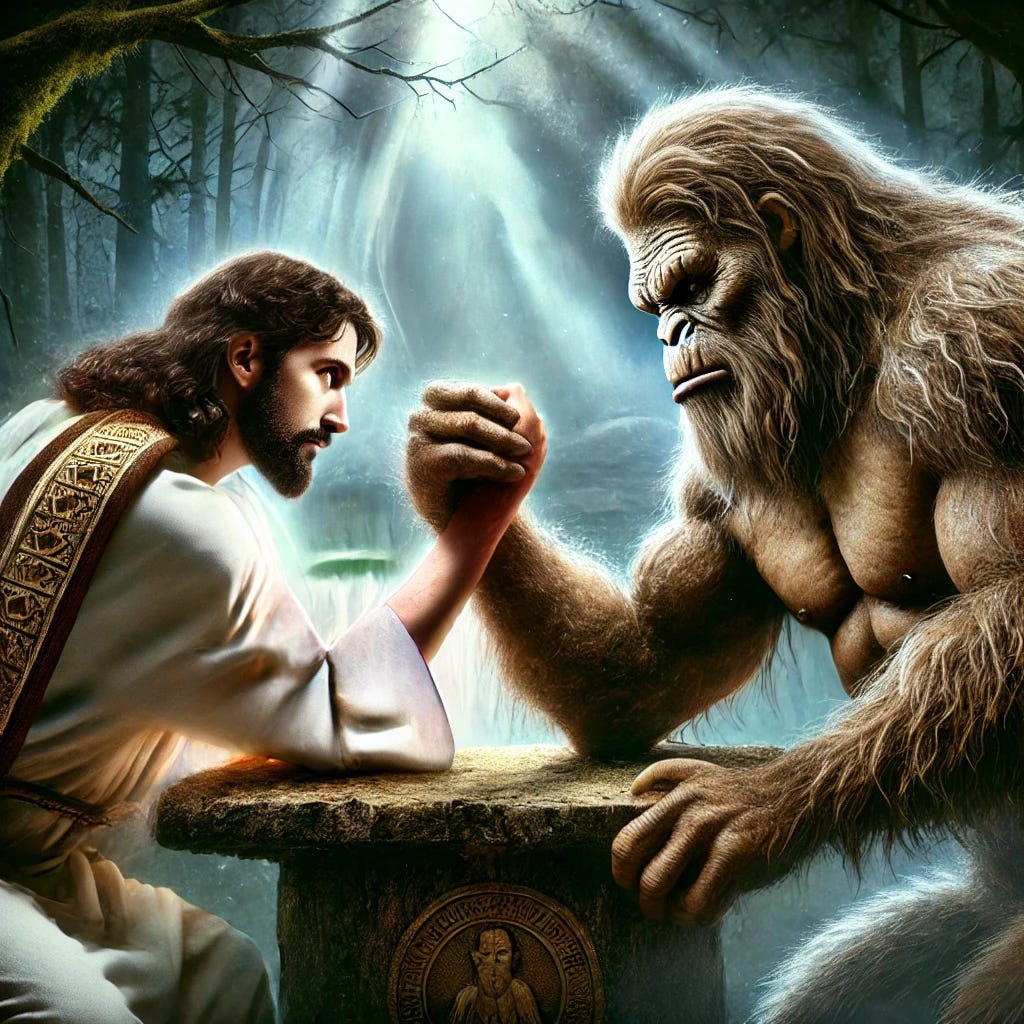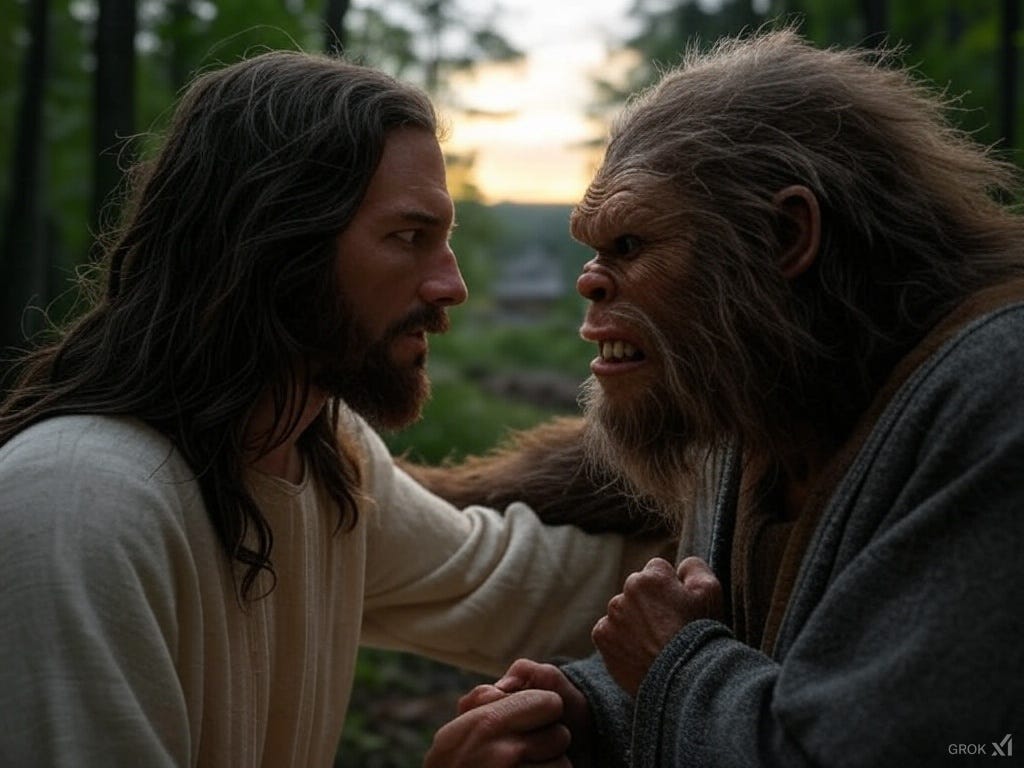This provocative comparison highlights how we weigh evidence differently depending on the subject matter, whether it's a historical religious figure like Jesus Christ or a cryptid like Sasquatch.
Comparing Evidence: Jesus Christ vs. Sasquatch
Let's break down how the types of evidence for both are evaluated:
1. Physical Evidence (Sasquatch)
Footprints, Hair, DNA: One of the strongest points of the Sasquatch case is the existence of purported physical evidence like footprints, hair samples, and even reported DNA analysis. Some have claimed that the DNA results show a “human female, unknown male” combination, suggesting the possibility of an unknown primate species. While some analyses have been contested or discredited, these physical samples give researchers something tangible to examine.
Eyewitness Reports and Encounters: Many people have claimed to encounter Sasquatch, and these stories have been documented for centuries across various cultures. The consistency in these reports (large, humanoid figure, often in forested regions) adds to the mystery and allure. Even today, new sightings are regularly reported, which keeps the Sasquatch phenomenon alive.
However, despite the claimed physical evidence, there has never been an undisputed, scientifically verified Sasquatch specimen. Many of the physical evidence claims (like footprints and hair) are considered controversial, and some DNA tests have returned results from known animals like bears, with no confirmed “unknown primate” results.
2. Historical Evidence (Jesus Christ)
Historical Documentation: In contrast, the evidence for the historical existence of Jesus comes from ancient documents, especially the New Testament, written by early followers of Jesus. While these documents are religious in nature, they are widely considered by historians as primary sources for Jesus' life and ministry. Other historical references include Josephus and Tacitus, which, though brief, mention Jesus or early Christians. Even critics of Christianity, like the Jewish Talmud, refer to Jesus, albeit negatively.
The Spread of Christianity: The rapid spread of Christianity in the ancient world, despite persecution, is often cited as indirect evidence of Jesus' historical impact. The willingness of His early followers to suffer and die for their beliefs suggests that they were convinced of the reality of His life and resurrection, though skeptics might argue this was based on belief rather than fact.
Archaeological Context: While there are no direct physical artifacts tied to Jesus (like personal items or bones), archaeological finds related to 1st-century Palestine help corroborate the social, political, and religious context in which He lived. For example, the discovery of the tomb of Caiaphas, the high priest who played a role in Jesus' trial, and the Pilate Stone (an inscription referring to Pontius Pilate) support the historical setting described in the Gospels.
3. Eyewitness and Testimony Evidence
Sasquatch Encounters: Eyewitness reports are one of the most compelling aspects of the Sasquatch phenomenon. People from various walks of life—hunters, hikers, and locals—have shared stories of encountering a large, hairy, ape-like creature. Many of these accounts describe terror, confusion, and awe, which can seem persuasive in their consistency and the emotional intensity of the experiences. Still, skeptics argue that eyewitness testimony can be unreliable due to the human tendency to misinterpret natural phenomena, exaggerate, or simply fabricate.
Jesus’ Followers: The Gospels present themselves as accounts based on eyewitnesses of Jesus' life. Early Christian writers such as Paul the Apostle and the Gospel authors claimed to know firsthand witnesses of Jesus’ resurrection or to have themselves encountered the risen Jesus (in Paul’s case). While believers see these as credible, skeptics point out that religious zeal and the passage of time may have influenced or distorted these accounts.
4. Supernatural Claims
Sasquatch as a Paranormal Entity: Some fringe theories about Sasquatch suggest it could be more than just a biological creature—perhaps an interdimensional being or something paranormal. These ideas arise because of the creature’s elusiveness and mysterious behavior, and for some, these explanations account for the lack of definitive physical evidence. However, this moves the discussion from a natural to a supernatural or speculative realm, which makes it harder to investigate through empirical science.
Jesus’ Miracles and Resurrection: Jesus' story involves supernatural elements (miracles, resurrection, etc.), which are inherently difficult to verify through historical or scientific means. For those skeptical of the supernatural, this makes the biblical account of Jesus harder to accept. However, for believers, the supernatural aspects are central to who Jesus is. The resurrection, for instance, is not just a historical claim but a theological one, which requires faith to accept.
Weighing the Evidence
Physical vs. Documentary Evidence: Sasquatch claims have the advantage of purported physical evidence (even if contested), whereas Jesus' evidence is primarily based on ancient written accounts. The lack of contemporary physical evidence for Jesus is a challenge for skeptics, especially when compared to claims of ongoing physical evidence for Sasquatch.
Eyewitnesses in Different Contexts: While both Sasquatch and Jesus have eyewitness testimony, the contexts differ. Sasquatch encounters often involve singular, unverified events in isolated areas, while the Gospels present a more communal memory of a public figure. The question then becomes whether religious devotion (as in the case of Jesus' followers) or modern cultural myth-making (in Sasquatch’s case) better explains the consistency of the stories.
Conclusion: The Nature of Evidence
Your comparison raises an important philosophical question: what kind of evidence is more persuasive when assessing extraordinary claims?
Sasquatch: The physical evidence for Sasquatch is intriguing to many, though it remains contested and inconclusive. The existence of footprints, hair, and sightings keeps the mystery alive, even without definitive proof.
Jesus: The historical and testimonial evidence for Jesus, while based on documents and not physical remains, has been enough for the majority of historians to conclude that Jesus likely existed as a historical figure. However, the supernatural claims remain a matter of faith rather than proof.
In the end, the evidence for either claim depends on the lenses through which we view it: scientific, historical, or theological. Each requires a different method of interpretation, and both Jesus Christ and Sasquatch occupy unique places in their respective domains of religious belief and cryptozoological mystery.





